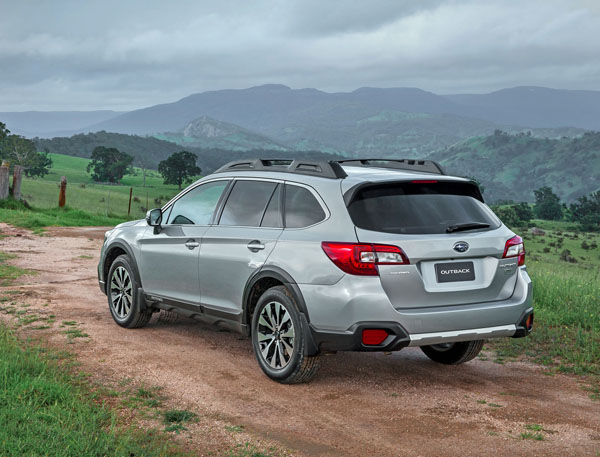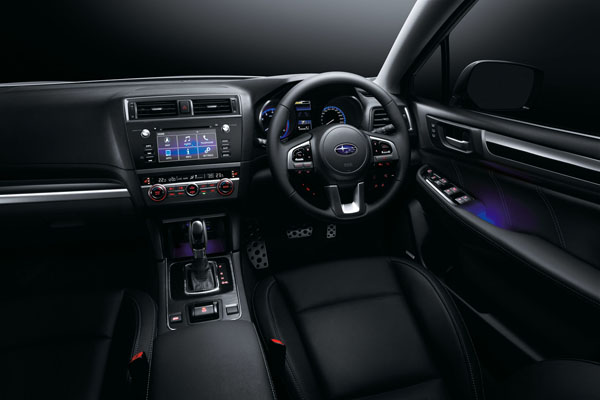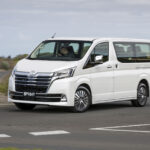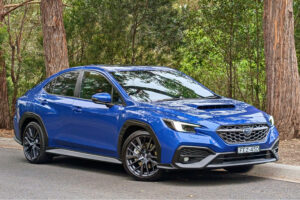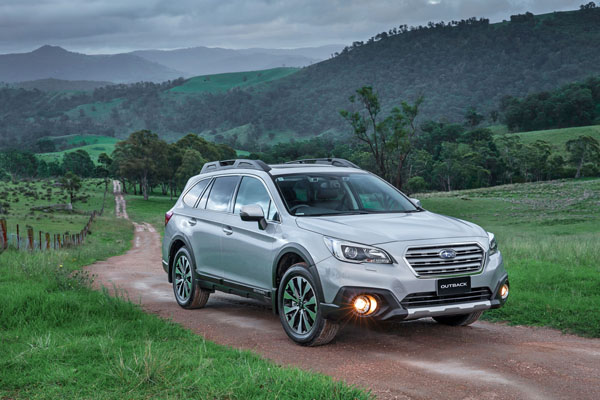
‘Commonsense’ is a word that’s almost guaranteed to appear somewhere in any road test on Subaru cars. The Japanese company makes its own way in the automotive world producing sensible products that appeal to conservative drivers. At least in the standard range of cars, the WRX is a notable exception!
This review is about the latest version of the Subaru Outback SUV in Premium 2.0D turbo-diesel format. The changes for MY2017 are more about sensible additions to the vehicle. Added sleekness to the lines and more chrome plating? You will need to look elsewhere if that’s what you’re after.
Subaru Outback 2.0D with automatic transmission comes in two equipment grades, the upper grade we tested is tagged as the Premium. The standard model is $36,490, the Premium comes in at $42,990. Outback Premium is well equipped, with a powered sunroof, leather trim, and eight-way power driver’s seat with memory function.
Importantly all Outback automatics, not just the Premium edition, are now equipped with Subaru’s EyeSight safety system. More about that in a moment.
STYLING
Commonsense shape of the Outback has an upright grille chiefly finished in body colour. The front foglights on every Outback variant now have integrated halogen Daytime Running Lights (DRLs). The rear is reasonably square to make room for a decent load area, but seem more comments about it in our Driving segment.
ENGINE / TRANSMISSION
The 2.0-litre turbo-diesel, boxer engine produces a modest 110 kW of power at 3600 rpm. Much more importantly it has a hefty 350 Nm of torque between 1800 and 2400 rpm. A major advantage of a CVT automatic transmission is that it keeps the engine neatly in this torque band virtually all of the time.
Drive is to all four wheels – Subaru would have it no other way.
INFOTAINMENT
Outback 2.0D, 2.5i Premium and 3.6R with factory fitted satellite navigation have the new Subaru Map Update Program that ensures the latest map version is installed before vehicle delivery. Also included is the Three Year Map Update Guarantee – a complimentary yearly map update during the program period. That is, provided the Outback has its scheduled services performed through an authorised Subaru Service Centre.
SAFETY
Subaru’s EyeSight driver assist system now has what the company calls Vision Assist features in the 2.0D Premium, Outback 2.5i Premium and 3.6R models. It has Blind Spot Monitoring; Lane Change Assist; High Beam Assist; Rear Cross Traffic Alert
That detects passing vehicles when reversing from parking spaces; Emergency Stop Signal (ESS), which detects an emergency brake situation and flashes the hazard lights automatically, to warn following vehicles.
EyeSight’s performance has been further improved by expanded recognition range to the left and right, as well as distant wide range. Automatic cruise control is based on information absorbed about the speed and distance of the vehicle ahead. Speed and inter-vehicle distance set by the driver are automatically maintained.
EyeSight can recognise red brake lights, thus enabling smoother deceleration and acceleration.
Drivers who love to send text messages while stopped at traffic lights are the bane of our existence these days. Subaru Front Vehicle Start Alert system senses that if the Outback does not move when the vehicle in front sets off, a warning display and sound occur. Personally I would prefer that the driver paid attention…
EyeSight is an exceptional system, however Subaru does warn that, “Operation may not be as expected depending on road, weather and vehicle conditions.” Drivers shouldn’t rely completely on the vehicle looking after them.
DRIVING
The front seats are large and comfortable with support in all the right places more most people. The rear seat has plenty of legroom, even with tall travellers in the front, its width can handle four adults, but two and a child makes more sense.
The boot is long and wide, but loses a lot of depth due to the fitment of a full-spare wheel. Those taking an Outback outback certainly need a big spare, but those in the suburbs would possibly prefer a deeper boot.
As some drivers are still becoming used to the different characteristics of CVT automatics Subaru has set it to ‘pretend’ it’s a conventional unit by building seven `steps’ that can come into play when driving hard or using it as a pseudo manual.
In Auto mode the CVT is beautifully smooth is it moves seamlessly through an infinite number of gears. In Manual mode, especially when using the steering wheel shift paddles the steps have rapid changes and give a sporty feel without any shift shock.
Fuel consumption wasn’t as low as anticipated, sitting in the seven to eight litres per hundred kilometres range on motorways and in the country. Rising to nine to eleven litres per hundred in town.
Driven at normal speeds the Subaru Outback 2.0D is one of the smoothest, quietest car on the market. When driven hard noise intrusion into the cabin is minimal, even at high speeds on quiet country roads.
Handling is competent, but there’s no denying it’s a largish SUV. Designed for commonsense drivers the suspension and steering lean in the direction of comfort in the endless comfort-versus-handling equation. We like it and never felt that it was going to cause any grief when we did hammer it at bends, and were well aware the electronic stability controls were on standby.
SUMMING UP
Subaru Outback’s commonsense design, voluminous interior and strong-torque boxer diesel appeal to buyers looking for a practical vehicle with a timeless design. Sales figures show it’s continuing to appeal, which comes as no surprise.




